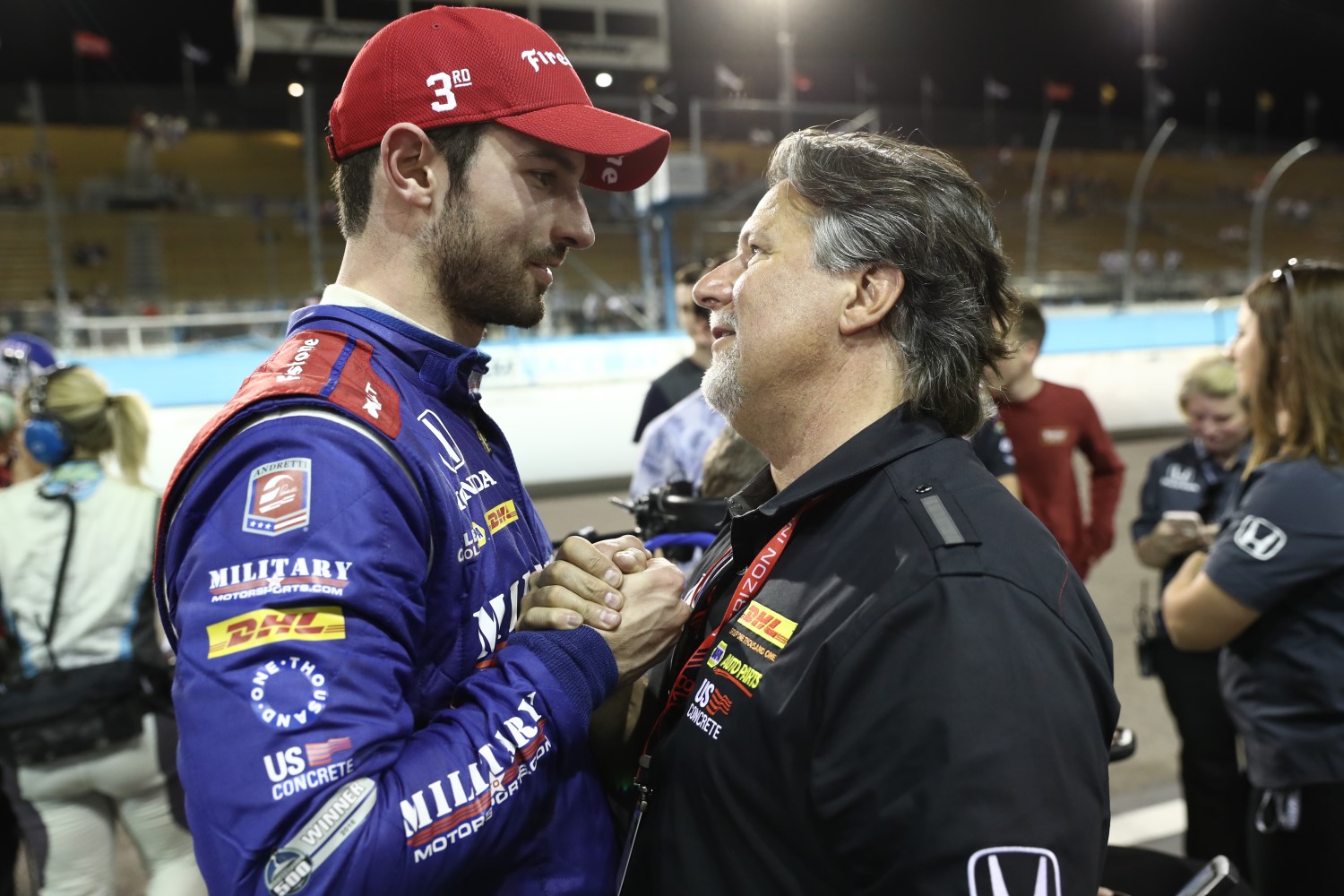How to fix the new IndyCar for the 2019 Indy 500
 |
| Team owner Michael Andretti tells Rossi after the Phoenix race how impressed he was with Rossi's talent level |
After the Indy 500 race on Sunday drivers had different views on what should be done because the number of passes were way down from recent years.
Simon Pagenaud was OK with the car the way it is, saying it rewards driver talent. It does at that – as evidenced by Alexander Rossi's passing at Phoenix and Indy Sunday. AR1.com has been telling its readers to watch this guy since 2009 when he was still a kid – an extremely talented kid. We think you finally can see it for yourself, but that isn't the point of this article.
But fans don't pay to see a follow-the-leader parade and have become accustomed to lot of passing. No doubt, passing makes a race more exciting.
Rossi feels the cars could use a bit more downforce, but Scott Dixon isn't sure what to do.
"Yeah, I don't know how to do it," Dixon told Autosport. "The downforce level is maybe not necessarily the issue.
"If the guy in front fumbles a little, but is still behind the car in front, he sucks up so that you can't pass him.
"It's almost like the cars need a little more drag to make that happen or maybe a little bit of downforce so you can stay closer, utilize it.
"It seemed like you had to come from quite a long way back. "Even when I got into a scenario with a clear track, slow competitors in front of us, it was very tough to get a run.
"There was no real wind, so no real corner that was distinctly harder than the others.
"Normally [Turn] 2 or 4 has a big shift and you can get some cars that are bad, get them off those corners. That just didn't play true today."
Ed Carpenter, who finished second to race-winner Will Power, added that while the car was rewarding to drive, it may need tweaks.
"It was a totally different type of race, I'll have to watch it from the outside to see from that perspective," he said.
"I like the way [the 2018 car] drives. It's definitely challenging to the driver.
"The old car [with the manufacturer aerokits], if you had a really good car, you couldn't really get rewarded by getting away or getting separation.
"I think if you have a good enough car, you're rewarded by being able to get away a little bit.
"I do think we need to maybe make little improvements just because it's so hard in dirty air to do much, to even have a better finish at the end.
"All-in-all, for this new kit, it's performed so well all year. Like every iteration of cars, the longer we have them, the better they'll get."
The AutoRacing1.com Proposed Fix
 |
 |
| The Handford device creates a bigger hole in the air, allowing the car in front to tow by. AR1.com proposes IndyCar test a smaller one than CART used back in 2002 (shown above). Test a 1/2" high one at Indy and if that isn't enough, enlarge it in 1/4" increments until it produces just enough extra hole in the air to enable more passing down the Indy straights. |
AR1.com feels the fix is easy, and will cost about $500 per car. IndyCar should consider adding a smaller version of the Handford Device CART ran back in 2001 and 2002.
That version (shown to the right) produced too big of a hole in the air and made the passing too artificial.
It was implemented to slow the cars down because they were making 1,000 HP and the speeds were getting too high. The fear of a car flying into the grandstands was high, so Dr. Mark Handford, a British aerodynamicist, came up with the vertical plate on the back of the wings.
It created a lot of drag and did slow the cars, but it had an added side-effect. The hole in the air it created resulted in a lot of passing for the lead – sometimes three times per lap. The fans loved it, but it was almost too many passes. It went too far and took too much of the driver skill out of it.
So let's not go so large this time.
We propose IndyCar ask Chevy and Honda to bump up the HP on the ovals (with increased boost) to offset the added drag the 'small' Handford Device will produce. We don't want to decrease the speed of the cars on the ovals, as much as we want to create a bit more passing (i.e. excitement) for the fans.
We know the Honda and Chevy engines can take few more inches of boost – they run a higher boost in qualifying for the Indy 500 and on all the road and street circuits.
Some calculations would need to be done to determine the added HP needed to offset the increased drag, depending on the size of the Handford Device that is settled on.
The beauty of the Handford Device – IndyCar can change the size of it from oval to oval to produce the desired effect. How much do flat pieces of carbon fiber cost the teams?
This solution isn't any more artificial than the push-to-pass button the drivers have at their disposal on road and street circuits.
At the end of the day, you want to send your paying customers home thoroughly entertained, and we feel a miniature version of the old Handford Device is the quickest and easiest fix. Mark C. reporting for AutoRacing1.com
